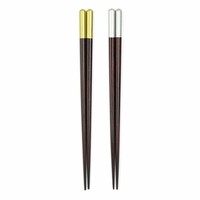Facts about Chopsticks
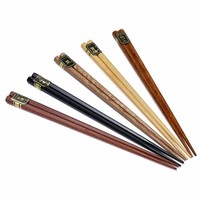
The limited use of chopsticks spread to other Asian countries in recent centuries with the arrival of Chinese immigrants in Southeast Asia, where food had traditionally been eaten with the hands.
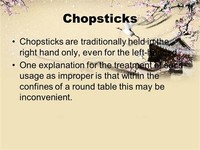
Chopsticks are traditionally held in the right hand only, even by left-handed people.
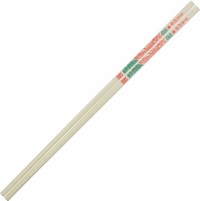
Disposable unlacquered chopsticks are used especially in restaurants.

Tip: Chopsticks generally should be held at the thicker end about a third along their length for balance and efficiency.

Like plastic chopsticks, metal chopsticks are more slippery than wood or bone chopsticks.
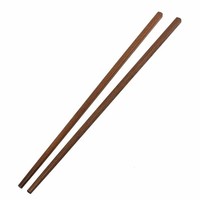
Chopsticks are a pair of small even-length tapered sticks used as the traditional eating utensils of China, Japan, Korea, Taiwan, Vietnam, and Thailand.

Blunt tapered chopsticks provide more surface area for holding food and for pushing rice into the mouth.

Chopsticks are made from a variety of materials including bamboo, plastic, wood, bone, gold, silver, stainless steel and other metals, horn, jade, coral and ivory.

The earliest evidence of a pair of chopsticks made out of bronze was excavated from Yin Ruins's Tomb 1005 at Houjiazhuang, Anyang, Henan, dated roughly 1200 B.C.E.

Held between the thumb and fingers of one hand, chopsticks are used tong-like to pick up portions of food, which are prepared and brought to the table in small and convenient pieces.
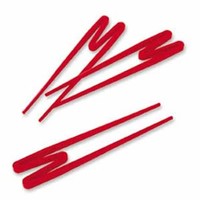
Pointed tapered chopsticks allow for easier manipulation of food and for picking out bones from whole cooked fish.

Chopsticks were also common household items of civilized Uyghurs on the Mongolian steppes during the sixth–eighth centuries.

In chopstick-using cultures, foods that cannot be easily separated with chopsticks are generally cut into small, bite-sized pieces during preparation.

Plastic chopsticks are not as effective as wood and bamboo chopsticks for picking up food, and cannot be used for cooking since high temperatures may melt the chopsticks and produce toxic compounds.

Chopsticks originated in ancient China as early as the Shang dynasty (1750-1040 B.C.E.

There have also been concerns regarding the use of certain disposable chopsticks made from inferior dark wood bleached white that may pose a health risk, causing coughing or even leading to asthma.

In China alone, an estimated 45 billion pairs of disposable chopsticks are used and thrown away annually, adding up to 1.7 million cubic meters of timber or 25 million fully grown trees every year.

Shorter chopsticks are generally used as eating utensils but are also used for cooking.

The character for this new meaning of "chopsticks" (?) for kuаi has the semantic element of bamboo added to the character meaning "fast" kuаi (?).
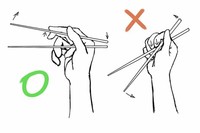
Hold the chopsticks upright with one of the tips lightly touching the table, and gently push the chopsticks down or gently loosen your grip for a moment to let both tips become equal in length.

Many rules of etiquette govern the proper conduct of the use of chopsticks.

Metal and stainless steel chopsticks are durable and are easy to clean and sanitize.
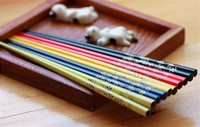
Wooden or bamboo chopsticks can be painted or lacquered to decorate them and make them waterproof, and inlaid with ivory and gold.

Metal chopsticks are sometimes roughened or scribed on the tapered end to make them less slippery when picking up foods.

Materials such as ivory, jade, coral, gold, and silver are typically used to make expensive and valuable chopsticks for special occasions.
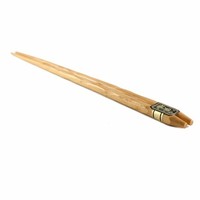
Natural wood chopsticks, like natural wood food preparation surfaces, have an innate antibacterial property absent in other materials.

Very long chopsticks, usually about 30 or 40 cm (11.8 to 15.7 inches), called saibashi (??) in Japan, are used for cooking, especially for deep frying foods, or for serving.

The matter surfaces of bamboo and wood chopsticks provide a good grip for holding food, but they can warp and deteriorate with continued use.

The earliest extant bronze chopsticks were excavated in sites dating from the fifth century B.C.E.

In Chinese, the old word for "chopsticks," and also in some varieties of modern Chinese such as Hokkien, was zhщ (MC: d?jwo-) (? Pinyin:zhщ, Minnan: t?).

Chopsticks have long been the primary eating utensil in China, Japan, Korea and Vietnam.

Modern plastic chopsticks for children are often decorated with popular cartoon characters.

The widespread use in Asian restaurants of disposable chopsticks made of wood or bamboo is contributing to deforestation in China.
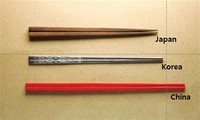
Chopsticks may also be used (except in Korea) as means for sweeping rice and other nominal morsels into the mouth directly from the bowl.

Wood and bamboo chopsticks are used for cooking because they are inexpensive, withstand high temperatures, and do not alter the taste of food.

Plastic chopsticks are cheap, do not conduct heat, and are resistant to wear.

To encourage the Chinese people to use and throw away less, a 5 percent tax was added to the price of chopsticks in China in April 2006.

